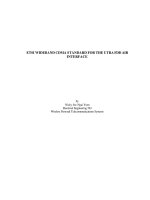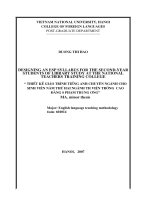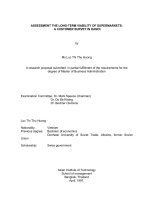Hand Off for the UHCI Host Controller
Bạn đang xem bản rút gọn của tài liệu. Xem và tải ngay bản đầy đủ của tài liệu tại đây (124.35 KB, 7 trang )
Hand Off for the UHCI Host Controller
Section 5 of the Universal Host Controller Interface (UHCI) Design Guide,
Revision 1.1 gives an example implementation of mouse and keyboard legacy
support and describes one way to hand off control of the host controller between the
BIOS and the UHCI host controller driver in the operating system. The key UHCI
register used in the example is the legacy support register (LEGSUP). For
implementers in a PCI device, the LEGSUP register is located at offset C0-C1h, in
function 2 PCI configuration space.
The Microsoft UHCI host controller driver also uses the LEGSUP register as the
primary interface in implementing the handoff of the host controller between the
operating system and the BIOS; the Microsoft host controller driver implementation
logic is described in this section of the article.
LEGSUP register structure. The LEGSUP register is a bitmap containing 16 bits.
The meaning of each of the 16 bits is fully specified in Section 5 of the Universal
Host Controller Interface (UHCI) Design Guide, Revision 1.1. A summary
description is given in the following table so the reader can interpret the bitmap
constant values used in later sections of this article without referring to the Design
Guide.
Table 1. LEGSUP register structure
Bit Name Description
15 (R/WC) A20PTS
1 = A20GATE passthrough sequence has
ended.
14 Reserved.
13 (R/W) USBPIRQDEN
1 = USB interrupt is routed to PIRQD
(default). 0 = Not routed to PIRQD. This bit
can be used to prevent the host controller from
generating an interrupt.
12 (RO) USBIRQS 1 = USB IRQ is active.
11 (R/WC) TBY64W 1 = Write to port 64h has occurred.
10 (R/WC) TBY64R 1 = Read to port 64h has occurred.
9 (R/WC) TBY60W 1 = Write to port 60h has occurred.
8 (R/WC) TBY60R 1 = Read to port 60h has occurred.
7 (R/W) SMIEPTE
1 = Enable generation of an SMI when
A20GATE passthrough sequence has ended.
0 = Disable (default).
6 (RO) PSS
1 = A20GATE passthrough sequence is
currently in progress.
0 = Not executing (default).
5 (R/W) A20PTEN 1 = Enable A20GATE passthrough sequence.
0 = Disable (default).
4 (R/W) USBSMIEN
1 = Enable SMI# generation on USB IRQ.
0 = Disable (default).
3 (R/W) 64WEN
1 = Enable I/O Trap and SMI# generation of
port 64h write.
0 = Disable (default).
2 (R/W) 64REN
1 = Enable I/O Trap and SMI# generation of
port 64h read.
0 = Disable (default).
1 (R/W) 60WEN
1 = Enable I/O Trap and SMI# generation of
port 60h write.
0 = Disable (default).
0 (R/W) 60REN
1 = Enable I/O Trap and SMI# generation of
port 60h read.
0 = Disable (default).
How the Microsoft host controller driver uses the LEGSUP register. The
Microsoft UHCI host controller driver writes the following value to LEGSUP for
normal HCD use: 0x2000. Note that this sets bit 13 and clears bit 4, which routes
USB interrupts to PIRQD and disables SMI# generation on a USB IRQ event. The
host controller driver sets bit 4 for BIOS/SMI use, which enables SMI# generation on
a USB IRQ event.
SOF MODIFY register. The SOF MODIFY register is a one-byte register that can
be used to modify the value used to generate timing on the USB. (For more
information, see section 2.1.6 of the Universal Host Controller Interface (UHCI)
Design Guide, Revision 1.1.) Guidelines for modification of frame time are
contained in Chapter 7 of the USB Specification.
How the Microsoft host controller driver uses the SOF MODIFY register. When
the Microsoft host controller driver takes control of the host controller from the
BIOS, it always reads the value of the SOF MODIFY register value established by
the BIOS and saves it in a per-device, per-host controller data structure.
USB COMMAND (USBCMD) register structure. The USBCMD register is a bit-
map containing 16 bits. The meaning of each of the 16 bits is fully specified in
Section 2.1.1 of the Universal Host Controller Interface (UHCI) Design Guide,
Revision 1.1. A summary description is given in the following table so the reader
can, without referring to the Design Guide, interpret the CMDREG bits that are set
and cleared in the pseudocode in later sections of this article.
Table 2. USBCMD register structure
Bit Name Description
15:8 Reserved.
7 (R/W) MAXP
1 = 64 bits.
0 = 32 bits.
6 (R/W) CF
Host controller driver software sets this bit as the last
action in its process of configuring the host controller;
has no effect on the hardware. Provided only as a
semaphore service for the software.
5 (R/W) SWDBG
1 = Debug mode.
0 = Normal mode.
4 (R/W) FGR
1 = host controller sends Global Resume signal on the
USB.
3 (R/W) EGSM 1 = host controller enters Global Suspend mode.
2 (R/W) GRESET
1 = host controller sends Global Reset signal on the
USB and then resets all its logic.
1 (R/W) HCRESET
1 = host controller resets its internal timers, counters,
state machines, and so on to their initial values.
0 (R/W) RS
1 = Run (host controller proceeds with execution of the
schedule).
0 = Stop (host controller completes current transaction
and then halts).
How the Microsoft host controller driver uses the USBCMD register. When it
takes control of the host controller from the BIOS, the Microsoft host controller
driver clears the RS bit to stop the host controller and clears the CF bit.
USB STATUS (USBSTS) register structure. The USBSTS register is a bitmap
containing 16 bits. The meaning of each of the 16 bits is fully specified in Section
2.1.2 of the Universal Host Controller Interface (UHCI) Design Guide, Revision
1.1. A summary description is given in the following table so the reader can, without
referring to the Design Guide, interpret the CMDSTS bits that are set and cleared in
the pseudocode in later sections of this article.
Table 3. USBSTS register structure
Bit Name Description
15:6 Reserved.
5 (R/WC) HcHalted Set to 1 by host controller when it is halted.
4 (R/WC)
Host Controller
Process Error
Set to 1 by host controller when it encounters a
consistency check error while processing a Transfer
Descriptor.
3 (R/WC)
Host System
Error
Set to 1 by host controller when a serious error
occurs during a host system access.
2 (R/WC) Resume Detect
Set to 1 by host controller when it receives a
RESUME signal from a USB device.
1 (R/W)
USB Error
Interrupt
Set to 1 by host controller when completion of a
USB transaction results in an error condition.
0 (R/W) USBINT
Set to 1 by host controller either when completion
of a USB transaction causes an interrupt or when a
short packet is detected.
How the Microsoft host controller driver uses the USBSTS register. During the
process of taking control of the host controller from the BIOS, the Microsoft host
controller driver monitors the HcHalted bit to determine if and when the host
controller is halted.
Operating System Takes Control of the UHCI Host
Controller
When the host controller driver is loaded and running, it can determine whether the
platform has a USB BIOS by the bits set in the LEGSUP register. A USB BIOS is a
BIOS that contains code to:
1* Configure the host controller.
2* Enable a USB keyboard and mouse.
3* Set up the host controller scheduler.
4* Route USB keyboard and mouse input to the 8042 Keyboard Controller
(KBC).
When a USB BIOS boots, if it contains the code that does the functions listed above
and has legacy keyboard support enabled, then it should always set bit 4 of the host
controller LEGSUP register and make sure bit 13 is cleared. Conversely, when a
BIOS boots that does not contain the code that does the above functions or when it
contains the code but has legacy keyboard support disabled, the BIOS should always
set bit 13 of the LEGSUP register and make sure bit 4 is cleared. This will ensure the
appropriate interaction between the BIOS and the Windows UHCI host controller
driver.
The following pseudocode shows the structure and logic of the entire StopBIOS
routine in the UHCI host controller.
Get a pointer to the per-device, per-host controller data structure
Read current value of SOF MODIFY register into data structure
Read current value of USB COMMAND REGISTER into data structure
Read current value of USB INTERRUPT ENABLE REGISTER into data structure
Read upper 20 bits of FRAME LIST BASE ADDRESS REGISTER into data structure
// Override SOF MODIFY value from BIOS with value in Registry, if there is
one.
If SOF MODIFY value is in the Registry
Read SOF MODIFY value from Registry
Save SOF MODIFY value read from Registry in data structure
Endif
// Prepare first host controller command.
Read current value of USB COMMAND REGISTER
Clear RS bit in the USB COMMAND REGISTER // Will stop host controller.
Clear CF bit in the USB COMMAND REGISTER // Will signal BIOS that OS has
control.
Write new value to USB COMMAND REGISTER
// Wait until host controller halts.
While total time elapsed is less than one millisecond
Write 0xFF to Interrupt Status Register // Clear all pending
interrupts.
If HcHalt bit in USB STATUS REGISTER is set
Break // Host controller has halted.
Endif
Endwhile
Read the current value of the LEGSUP register
Save read value of LEGSUP register in data structure
// If any bits in the bit pattern 0x00BF are set in read LEGSUP value, then
the platform
// BIOS has legacy keyboard support code and legacy keyboard support is
enabled for
// the platform.
If ((LEGSUP value) AND (0x00BF))!= 0 then
Set USBBIOS flag in data structure // Platform has USB BIOS.
Clear SMI enable bit (bit 4) in read LEGSUP value
Write new value to LEGSUP register
Read current value of LEGSUP register
Write 0x2000 to the LEGSUP register // Route USB interrupt to PIRQD
and
// disable SMI# interrupt generation.
Endif
Return(STATUS_SUCCESSFUL)
BIOS Takes Control of the UHCI Host Controller
The following pseudocode shows the structure and logic of the StartBIOS routine
for the UHCI host controller. Note that whenever StartBIOS is executed, it can be
assumed that StopBIOS has been executed earlier; all StartBIOS calls are
conditional and performed only if the USBBIOS flag is set in the per-device, per-
controller data structure maintained by the host controller driver. This means that a
set of host controller register values the BIOS needs to take control of the host
controller are saved in the same data structure.
Get pointer to per-device, per-host controller data structure
// Clear all pending interrupts.
Write 0xFF to Interrupt Status Register
// Restore host controller register values saved at last BIOS to operating
system handoff.
Write value from data structure to HC USB INTERRUPT ENABLE REGISTER
Write value from data structure to HC FRAME LIST BASE ADDRESS REGISTER
// Enable routing of USB keyboard and mouse interrupts to SMI#.
Write value from data structure into HC LEGSUP register
Read value of HC LEGSUP register into data structure
Set USBSMIEN bit (bit 4) of LEGSUP register value in data structure
Write new value from data structure into HC LEGSUP register








